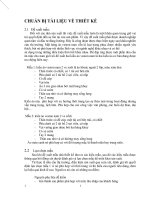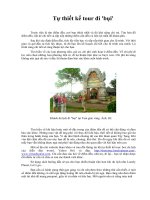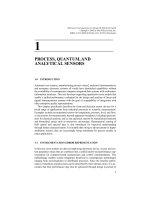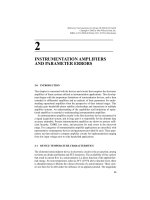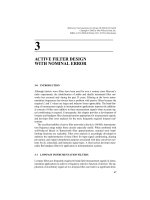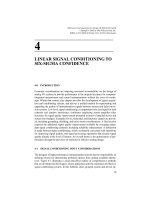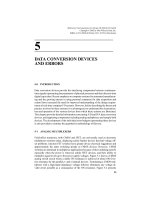Tài liệu Multisensor thiết bị đo đạc thiết kế 6o (P6) pptx
Bạn đang xem bản rút gọn của tài liệu. Xem và tải ngay bản đầy đủ của tài liệu tại đây (449.27 KB, 25 trang )
121
6
SAMPLING AND RECONSTRUCTION
WITH INTERSAMPLE ERROR
6-0 INTRODUCTION
A fundamental requirement of sampled-data systems is the sampling of continuous-
time signals to obtain a representative set of numbers that can be used by a digital
computer. The primary goal of this chapter is to provide an understanding of this
process. The first section explores theoretical aspects of sampling and the formal
considerations of signal recovery, including ideal Wiener filtering in signal interpo-
lation. Aliasing of signal and noise are considered next in a detailed development
involving a heterodyne basis of evaluation. This development coordinates signal
bandwidth, sample rate, and band-limiting prior to sampling to achieve minimum
aliasing error under conditions of significant aliasable content. The third section ad-
dresses intersample error in sampled systems, and provides a sample-rate-to-signal-
bandwidth ratio ( f
s
/BW) expressing the step-interpolator representation of sampled
data in terms of equivalent binary accuracy. The final section derives a mean-
squared error criterion for evaluating the performance of practical signal recovery
techniques. This provides an interpolated output signal accuracy in terms of the cor-
responding minimum required sample rate and suggests a data conversion system
design procedure that is based on considering system output performance require-
ments first.
6-1 SAMPLED DATA THEORY
Observation of typical sensor signals generally reveals band-limited continuous
functions with a diminished amplitude outside of a specific frequency band, except
for interference or noise, which may extend over a wide bandwidth. This is attribut-
able to the natural roll-off or inertia associated with actual processes or systems
providing the sensor excitation. Sampled-data systems provide discrete signals of
Multisensor Instrumentation 6
Design. By Patrick H. Garrett
Copyright © 2002 by John Wiley & Sons, Inc.
ISBNs: 0-471-20506-0 (Print); 0-471-22155-4 (Electronic)
finite accuracy from continuous signals of true accuracy. Of interest is how much
information is lost by the sampling operation and to what accuracy an original con-
tinuous signal can be reconstructed from its sampled values. The consideration of
periodic sampling offers a mathematical solution to this problem for band-limited
sampled signals of bandwidth BW. Signal discretization is illustrated for the two
classifications of nonreturn-to-zero (NRZ) sampling and return-to-zero (RZ) sam-
pling in Figure 6-1. This figure represents the two sampling classifications in both
the time and frequency domains, where
is the sampling function width and T the
sampling period (the latter the inverse of sample rate f
s
). The determination of spe-
cific sample rates that provide sampled-data accuracies of interest is a central theme
of this chapter.
The provisions of periodic sampling are based on Fourier analysis and include
the existence of a minimum sample rate for which theoretically exact signal recon-
struction is possible from the sampled sequence. This is significant in that signal
sampling and recovery are considered simultaneously, correctly implying that the
design of data conversion and recovery systems should also be considered jointly.
The interpolation formula of equation (6-1) analytically describes the approxima-
tion ˆx(t) of a continuous-time signal x(t) with a finite number of samples from the
sequence x(nT). ˆx(t) is obtained from the inverse Fourier transform of the input se-
quence, which is derived from x(t)·ˆp(t) as convolved with the ideal interpolation
function H( f ) of Figure 6-2. This results in the sinc amplitude response in the time
domain owing to the rectangular characteristic of H( f ). Due to the orthogonal be-
havior of equation (6-1) only one nonzero term is provided at each sampling instant.
Contributions of samples other than ones in the immediate neighborhood of a spe-
cific sample diminish rapidly because the amplitude response of H( f ) tends to de-
crease inversely with the value of n. Consequently, the interpolation formula pro-
vides a useful relationship for describing recovered band-limited sampled-data
signals, with T chosen sufficiently small to prevent signal aliasing. Aliasing is dis-
cussed in detail in the following section. Figure 6-3 shows the behavior of this in-
terpolation formula including its output approximation ˆx(t).
ˆx(t) = F
–1
{ f [x(nT)] · H( f )} (6-1)
=
Α
x
n=–x
Ά
T
͵
BW
–BW
x(nT)e
–j2
fnT
·
· e
j2
ft
· df
= T
Α
x
n=–x
x(nT)
= 2TBW
Α
x
n=–x
x(nT)
A formal description of this process was provided both by Wiener [13] and Kol-
mogoroff [15]. It is important to note that the ideal interpolation function H( f ) uti-
sin 2
BW(t – nT)
ᎏᎏ
2
BW(t – nT)
e
j2
BW(t–nT)
– e
–j2
BW(t–nT)
ᎏᎏᎏ
j2
(t – nT)
122
SAMPLING AND RECONSTRUCTION WITH INTERSAMPLE ERROR
123
FIGURE 6-1. Sampled data time- and frequency-domain representation.
lizes both phase and amplitude information in reconstructing the recovered signal
xˆ(t), and is therefore more efficient than conventional linear filters. However, this
ideal interpolation function cannot be physically realized because its impulse re-
sponse H( f ) is noncausal, requiring an output that anticipates its input. As a result,
practical interpolators for signal recovery utilize amplitude information that can be
made efficient, although not optimum, by achieving appropriate weighting of the
reconstructed signal. These principles are observed Section 6-4.
124
SAMPLING AND RECONSTRUCTION WITH INTERSAMPLE ERROR
FIGURE 6-2. Ideal sampling and recovery.
FIGURE 6-3. Signal interpolation.
A significant consideration imposed upon the sampling operation results from
the finite width
of practical sampling functions, denoted by p(t) in Figure 6-1.
Since the spectrum of a sampled signal consists of its original baseband spectrum
X( f ) plus a number of images of this signal, these image signals are shifted in fre-
quency by an amount equal to the sampling frequency f
s
and its harmonics mf
s
as a
consequence of the periodicity of p(t). The width of
determines the amplitude of
these signal images, as attenuated by the sinc functions described by the dashed
lines of XЈ( f ) in Figure 6-1, for both RZ and NRZ sampling. Of particular interest is
the attenuation impressed upon the baseband spectrum of XЈ( f ) corresponding to
the amplitude and phase of the original signal X( f ). A useful criterion is to consider
the average baseband amplitude error between dc and the signal BW expressed as a
percentage of the full-scale departure from unity gain. Also, digital processor band-
width must be sufficient to support these image spectra until their amplitudes are at-
tenuated by the sinc function to preserve signal fidelity. The mean sinc amplitude
error is expressed for RZ and NRZ sampling by equations (6-2) and (6-3). The sam-
pled-data bandwidth requirement for NRZ sampling is generally more efficient in
system bandwidth utilization than the 1/
null provided by RZ sampling. The mini-
mization of mean sinc amplitude error may also influence the choice of f
s
. The fold-
ing frequency f
o
in Figure 6-1 is an identity equal to f
s
/2, and the specific NRZ sinc
attenuation at f
o
is always 0.636, or –3.93 dB.
ෆ
R
ෆ
Z
ෆ
ෆ
s
ෆ
i
ෆ
n
ෆ
c
ෆ
ෆ
%
ෆ
F
ෆ
S
ෆ
=
1 – ·
· 100% (6-2)
ෆ
R
ෆ
Z
ෆ
ෆ
s
ෆ
i
ෆ
n
ෆ
c
ෆ
ෆ
%
ෆ
F
ෆ
S
ෆ
=
1 –
· 100% (6-3)
RZ sampling is primarily used for multiplexing multichannel signals into a sin-
gle channel, such as encountered in telemetry systems. Figure 6-1 provides that the
dc component of RZ sampling has an amplitude of
/T, its average value or sam-
pling duty cycle, which may be scaled as required by the system gain. NRZ sam-
pling is inherent in the operation of all data-conversion components encountered in
computer input–output systems, and reveals a dc component proportional to the
sampling period T. In practice, this constant is normalized to unity by the l/T im-
pulse response associated with the transfer functions of actual data-conversion
components.
Note that the sinc function and its attenuation with frequency in a sampled-data
system is essentially determined by the duration of the sampled-signal representa-
tion X
Ј
(t) at any point of observation, as illustrated in Figure 6-1. For example, an
A/D converter with a conversion period T double the value employed for a follow-
ing connected D/A converter will exhibit an NRZ sinc function having twice the at-
tenuation rate versus frequency as that of the D/A, which is attributable to the trans-
formation of the sampled-signal duration. D/A oversampling accordingly offers
reduced output sinc error, illustrated by Figure 6-15.
sin
BWT
ᎏᎏ
BWT
1
ᎏ
2
sin
BW
ᎏᎏ
BW
ᎏ
T
1
ᎏ
2
6-1 SAMPLED DATA THEORY
125
6-2 ALIASING OF SIGNAL AND NOISE
The effect of undersampling a continuous signal is illustrated in both the time and
frequency domains in Figure 6-4. This demonstrates that the mapping of a signal to
its sampled-data representation does not have an identical reverse mapping if it is
reconstructed as a continuous signal when it is undersampled. Such signals appear
as lower-frequency aliases of the original signal, and are defined by equation (6-4)
when f
s
< 2 BW. As the sample rate f
s
is reduced. samples move further apart in the
time domain, and signal images closer together in the frequency domain. When im-
age spectrums overlap, as illustrated in Figure 6-4b, signal aliasing occurs. The con-
sequence of this result is the generation of intermodulation distortion that cannot be
removed by later signal processing operations. Of interest is aliasing at f
o
between
the baseband spectrum, representing the amplitude and phase of the original signal,
and the first image spectrum. The folding frequency f
o
is the highest frequency at
which sampled-data signals may exist without being undersampled. Accordingly, f
s
must be chosen greater than twice the signal BW to ensure the absence of signal
aliasing, which usually is readily achieved in practice.
f
alias
= [ f
s
– BW] f
s
< 2 BW
= nonexistent f
s
Ն 2 BW (6-4)
Of greater general concern and complexity is noise aliasing in sampled-data sys-
tems. This involves either out-of-band signal components, such as coherent inter-
126
SAMPLING AND RECONSTRUCTION WITH INTERSAMPLE ERROR
FIGURE 6-4. Time (a) and frequency (b) representation of undersampled signal aliasing.
ference or random noise spectra, present above f
o
and therefore undersampled. One
or more of these sources are frequently present in most sampled-data systems. Con-
sequently, the design of these systems should provide for the analysis of noise alias-
ing and the coordination of system parameters to achieve the aliasing attenuation of
interest. Understanding of baseband aliasing is aided with reference to Figures 6-5
and 6-6. The noise aliasing source bands shown are heterodyned within the base-
band signal between dc and f
o
, derived by equation (6-5) as mf
s
– BW Յ f
noise
< mf
s
+ BW, as a consequence of the sampling function spectra, which arise at multiples
of f
s
. The resulting combination of signal and aliasing components generate inter-
modulation distortion proportional to the baseband alias amplitude error derived by
equations (6-6) through (6-10).
mf
s
– BW Յ f
noise
< mf
s
+ BW alias source frequencies (6-5)
f
coherent alias
= |mf
s
– f
coh
| at baseband (6-6)
= 24 Hz – 23 Hz
= 1 Hz (m = 1)
coherent alias
= V
coh%FS
· filter attn · sinc (6-7)
= 50%FS · · sinc
= 50%FS · · sinc
= 50%FS · (0.0024) · (0.998)
= 0.12%FS with presampling filter
|24 – 23|
ᎏ
24
1
ᎏᎏ
Ί
1
+
ᎏ
2
3
3
ᎏ
6
|mf
s
– f
coh
|
ᎏᎏ
f
s
1
ᎏᎏ
Ί
1
+
ᎏ
f
c
f
o
c
h
ᎏ
2
n
6-2 ALIASING OF SIGNAL AND NOISE
127
FIGURE 6-5. Coherent interference aliasing without presampling filter.
N
alias
=
Α
# source bands
0
(V
noise
rms)
2
· (filter attn)
2
at baseband (6-8)
=
Α
f
hi
/f
s
0
(0.1 V
FS
)
2
΄΅
2
=
Α
1
0
(0.01 V
2
FS
)
΄΅
2
= 0.038 × 10
–6
· V
2
FS
watt into 1 ⍀
SNR
random alias
= (6-9)
random alias
= (6-10)
=
= 0.027%FS with presampling filter
Coherent alias frequencies capable of interfering with baseband signals are de-
fined by equation (6-6). The amplitude of the aliasing error components expressed
as a percent of full scale are provided for both NRZ and RZ sampling by equation
(6-7) with the appropriate sinc function argument. Note that this equation may be
evaluated to determine the aliasing amplitude error with or without presampling
filtering and its effect on aliasing attenuation. For example, consider a 1 Hz signal
͙
2
ෆ
· 100%
ᎏᎏᎏ
͙V
ෆ
2
FS
ෆ
/0
ෆ
.0
ෆ
3
ෆ
8
ෆ
×
ෆ
1
ෆ
0
ෆ
–6
ෆ
V
ෆ
2
FS
ෆ
͙
2
ෆ
· 100%
ᎏᎏ
͙
S
ෆ
N
ෆ
R
ෆ
ra
ෆ
nd
ෆ
om
ෆ
al
ෆ
ia
ෆ
s
ෆ
V
s
2
rms
ᎏ
N
alias
1
ᎏᎏ
Ί
1
+
ᎏ
2
3
4
ᎏ
6
1
ᎏᎏ
Ί
1
+
ᎏ
f
f
c
s
ᎏ
2n
128
SAMPLING AND RECONSTRUCTION WITH INTERSAMPLE ERROR
FIGURE 6-6. Random interference aliasing without presampling filter.
BW for a NRZ sampled-data system with an f
s
of 24 Hz. A 23 Hz coherent inter-
fering input signal of –6 dB amplitude (50%FS) will be heterodyned both to 1 Hz
and 47 Hz by this 24 Hz sampling frequency, with negligible sinc attenuation at 1
Hz and approximately –30 dB at 47 Hz, for a coherent aliasing baseband aliasing
error of 50%FS, applying equation (6-7) in the absence of a presampling filter.
This is illustrated by Figure 6-5. The addition of a lowpass three-pole (n = 3)
Butterworth presampling filter with a 3 Hz cutoff frequency, to minimize filter er-
ror to 0
ෆ
.
ෆ
1
ෆ
%
ෆ
F
ෆ
S
ෆ
over the signal BW, then provides –52 dB input attenuation to the
23 Hz interfering signal for a negligible 0.12%FS baseband aliasing error shown
by the calculations accompanying equation (6-7). This filter may be visualized su-
perimposed on Figure 6-5.
A more complex situation is presented in the case of random noise because of its
wideband spectral characteristic. This type of interference exhibits a uniform ampli-
tude representing a Gaussian probability distribution. Aliased baseband noise pow-
er N
alias
is determined as the sum of heterodyned noise source bands between mf
s
–
BW Յ f
noise
. These bands occur at intervals of f
s
in frequency, shown in Figure 6-6
up to a –3 dB band-limiting f
hi
, such as provided by an input amplifier cutoff fre-
quency preceding the sampler, with f
hi
/f
s
total noise source bands contributing. N
alias
may be evaluated with or without the attenuation provided by a presampling filter
in determining baseband random noise aliasing error, which is expressed as an
aliasing signal-to-noise ratio in equations (6-9) and (6-10). The small sinc ampli-
tude attenuation encountered at baseband is omitted for simplicity.
Consider a –20 dB (0.1 FS) example V
noise
rms level extending from dc to an f
hi
of 1 kHz. Solution of equations (6-8) through (6-10), in the absence of a filter,
yields 0.42 volts full-scale squared (watts) into 1 ohm as N
alias
with an f
s
as before of
24 Hz and 42 source bands summed to 1 kHz for a random noise aliasing error of
90%FS. Consideration of the previous 1 Hz signal BW and 3 Hz cutoff, three-pole
Butterworth lowpass filter provides –54 dB average attenuation over the first noise
source band centered at f
s
. Significantly greater filter attenuation is imposed at high-
er noise frequencies, resulting in negligible contribution from summed noise source
bands greater than one to N
alias
. The presampling filter effectiveness, therefore, is
such that the random noise aliasing error is only 0.027%FS.
Table 6-1 offers an efficient coordination of presampling filter specifications
employing a conservative criterion of achieving –40 dB input attenuation at f
o
in
terms of a required f
s
/BW ratio that defines the minimum sample rate for prevent-
ing noise aliasing. The foregoing coherent and random noise aliasing examples
meet these requirements with their f
s
/BW ratios of 24 employing the general ap-
plication three-pole Butterworth presampling filter, whose cutoff frequency f
c
of
three times signal BW provides only a nominal device error addition while achiev-
ing significant antialiasing protection. RC presampling filters are clearly least ef-
ficient and appropriate only for dc signals considering their required f
s
/BW ratio to
obtain –40 dB aliasing attenuation. Six-pole Butterworth presampling filters are
most efficient in conserving sample rate while providing equal aliasing attenuation
at the cost of greater filter complexity. A three-pole Bessel filter is unparalleled in
its linearity to both amplitude and phase for all signal types as an antialiasing fil-
6-2 ALIASING OF SIGNAL AND NOISE
129
ter, but requires an inefficient f
s
/BW ratio to compensate for its passband ampli-
tude rolloff. The following sections consider the effect of sample rate on sampled
data accuracy—first as step-interpolated data principally encountered on a com-
puter data bus, and then including postfilter interpolation associated with output
signal reconstruction.
6-3 STEP-INTERPOLATED DATA INTERSAMPLE ERROR
The NRZ-sampling step-interpolated data representation of Figure 6-7 denotes the
way converted data are handled in digital computers, whereby the present sample is
current data until a new sample is acquired. Both intersample and aperture volts,
⌬V
pp
and ⌬VЈ
pp
, respectively, are derived in this development as time–amplitude re-
lationships to augment this understanding.
In real-time data conversion systems, the sampling process is followed by quan-
tization and encoding, all of which are embodied in the A/D conversion process de-
scribed by Figure 5-11. Quantization is a measure of the number of discrete ampli-
130
SAMPLING AND RECONSTRUCTION WITH INTERSAMPLE ERROR
TABLE 6-1. Coordination of Sample Rate, Signal Bandwidth, and Sinc Function with
Presampling Filter for Aliasing Attenuation at the Folding Frequency
f
s
/BW for –40 dB
Attenuation at f
o
Including Filter
ෆ
%
ෆ
F
ෆ
S
ෆ
Presampling Filter Poles –4 dB Sinc and Filter f
c
of per Signal Type
________________________________________________ _____________________________ ________________________
Application RC Bessel Butterworth 20 BW 10 BW 3 BW DC, Sines Harmonic
DC signals 1 2560 0.10 1.20
Linear phase 3 80 0.10 0.10
General 3 24 0.10 0.11
Brickwall 6 12 0.05 0.15
FIGURE 6-7. Intersample and aperture error representation.
